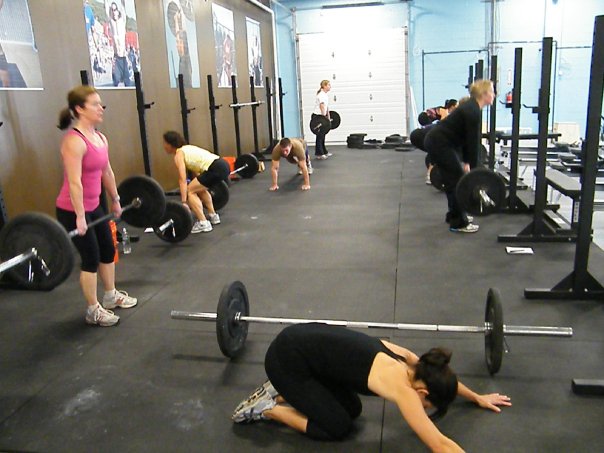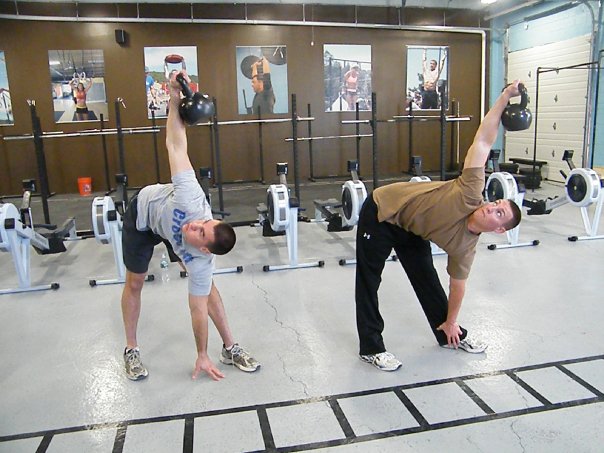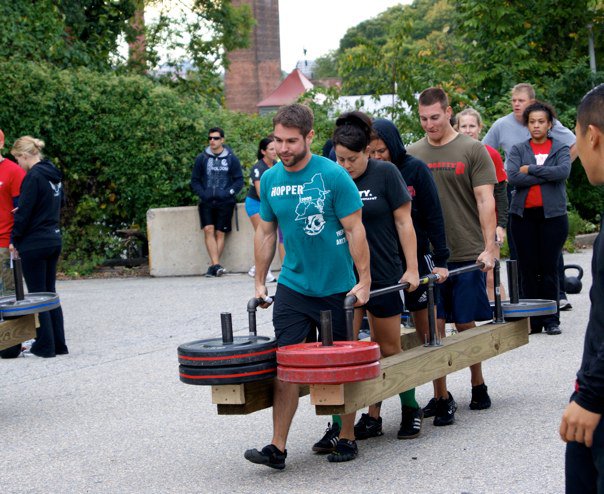15 Years of CrossFit
by Erik Castiglione
Today: CrossFit HQ has shifted its focus from competition to general health and wellness. This was the original intent of the movement, with “fitness” being a state of “super wellness.” If you log on to crossfit.com today, you’ll see WODs demoed with senior citizens using household items in a living room. This shift began in January 2020, and it just goes to show that fitness can be achieved anywhere, with minimal space, and a little use of creativity. As many of us don’t have equipment at home during this pseudo-quarantine, this is an important lesson to learn. Our “Home WOD” program is designed to keep your base of conditioning, and improve your bodyweight movements, so that you don’t lose strength until we can actually use weights again. This is perfectly in-line with HQ’s vision for CrossFit right now. BUT, things, were not always thus. 15 years ago, today, I had my first CrossFit workout. I’ve watched CrossFit grow from a counterculture movement to the mainstream, and I’ve witnessed the tarnishing of its reputation along the way. I use the lessons I’ve learned in the last decade and a half to deliver a program to all of you that will keep you progressing in the long-term, while MOST IMPORTANTLY staying healthy. To get to this point, I’ve made every mistake in the book. When I advise you against something, it’s because I know from experience that it’s a recipe for disaster. If you’d like to follow my journey over the last 15 years, please keep reading. If not, here’s the TL;DR version of my lessons learned:
- FOLLOW A PROGRAM. When you mix and match, you get HURT. Strict adherence to a shitty program will get you better results than sporadic adherence to the world’s best program.
- If you focus on technique, CrossFit does not cause injuries. Instead, it exposes them. I’ve coached literally thousands of people. Many live with pain EVERY DAY and assume that it’s normal. CrossFit boosts the business of PT’s and chiros, because we encourage members to resolve their pain rather than live with it.
- You can continue training when injured if you’re smart. Figure what you can do and focus on that.
- When you first begin, you will see gains in both strength and conditioning. Eventually, these gains will slow. You’ll need to prioritize strength, or technique, or whatever your current weakness is to continue making gains. Work on one weakness until it become a mediocrity, and then pick another weakness. Never stop.
- NEVER neglect the basics. Everyone wants to be able to perform sexy movements like muscle ups and handstand push-ups. Gymnasts spend years mastering wrist flexibility and core strength before ever getting inverted for a reason. Don’t throw away time spent doing hollow holds or L-sits; they’ll pay dividends down the road.
- ALWAYS BE A STUDENT. I’ve spent a decade learning to coach and program. I’m still learning. While I hope you’ll trust the program, I encourage you to ask questions. I want you all to be inquisitive and to understand the “why” behind things. That’s part of the reason I started the “Viking Lore” newsletter. If a coach ever shuts you down for questioning something without an explanation of why, they’re not a good coach. Our staff will always explain the “why.”
Now, for those interested, here’s a timeline of my history with CrossFit:
March 28th, 2005: This was a Monday, which of course means that it was international bench press day. My older brother, Jeff, was home from college on spring break (Williams College always had late breaks). Jeff had decided that he was going to join the military, so he had been looking for ways to train for Officer Candidate School. We were at WOW! Fitness on Shield Street, and he indulged me in benching. As the older brother, he was a little annoyed that my bench was stronger than his. So, in turn, he decided to put me through something called “CrossFit.” We did something called “Fran”, using a 95 lb straight bar. Since neither of us knew what a thruster was, we wound up doing push presses. Neither of us could kip, so all pull-ups were strict. My brother finished in 4 minutes and change. I started out with 21 unbroken presses, and 21 unbroken pull-ups. My pull-ups went to shit after that, and I wound up taking 6ish minutes. When we finished, Jeff introduced me to the Mainsite – crossfit.com.
In 2005, there were 13 CrossFit affiliates. None were on the east coast. Enthusiasts could follow the WOD by going to crossfit.com (you still can). The site programs 3 days of work followed by 1 day of rest. When I first started, I didn’t understand the concept of scaling, and many of the workouts looked impossible.
For the next four and a half years, I cherry picked the WODs when they looked like something I could do. I was “that guy” at Payne Whitney Gym – you know, the one that hogs several stations and rotates through them. CrossFit prided itself in being unorthodox and underground, and I relished it too. I got a bunch of stares for wearing my OG “Infidel” and “Unfuckwithable” shirts. And of course, people thought I was crazy and/or stupid when the WOD was “virtual shoveling.” (In hindsight, I was dumb. What a moronic exercise!)
October 8th, 2009: This was Thursday, the day after my birthday. I was no longer making any strength gains lifting, and I was just bored at WOW! I had heard that CrossFit affiliates were popping up around the nation, and lo and behold, there was one in West Hartford. I stopped in around 10 am to talk to the owner, Merle. He was between classes, but he let me do the workout of the day anyway (deadlifts and rope climbs). I learned that they had literally JUST opened that week, and I signed up.
October 9th, 2009: I participated in my first class at 830am. It was just me and one other person, a tall, blonde woman named Camilla. The warm-up was comprised of running, push-ups, and legless rope climbs. I was gassed after it and questioned my choice to join. WOD: 3×5 Front Squats, and then a 500m row, 500m ski, 500m row done for time. I had avoided front squats as much as possible over the last 4 years, because I wasn’t good at them and they hurt my wrist. I don’t recall what I hit, I think it might have been 165 or 185 for 5 – something significantly lower than my back squat. In the metcon, I was pulling as hard as I could, but somehow Camilla was staying ahead of me on the row. I caught her on the ski (I would grow to HATE this machine), but she passed me on the last row. I learned later that she was a collegiate rower, and that my technique was terrible and inefficient.
October 2009 – March 2010: I continued my workouts with the 830 class. Marri was already a member, and I remember when Brenda joined. I would attend class 6 days a week, since the gym wasn’t open on Sundays. I made tremendous progress for 2 months, and then I started regressing. I soon learned the importance of rest days. By resting on Thursdays AND Sundays, I began making progress again. I was 23 and became known as “the kid”. Merle told me that some day he could see me owning a CrossFit gym. At the time, I laughed. But, he’s always been very good at predicting future trends.

March 2010: I got a job working for the Navy as an engineer, in Philadelphia. I was already headed down to visit my girlfriend at the time, when I got the call. I immediately found a CrossFit gym down there. THEN, I focused on finding an apartment. You know, priorities.
September-October 2010: Big two months here – I got my CrossFit L1 certification, officially becoming a CrossFit coach in September. In October, I entered my first team CrossFit competition. I had only competed as an individual up to that point. It was team competition that really gave me the competitive “bug.”
2011-2013: Enter Reebok, and the beginning of Rich Froning’s reign. It was in these few years that the CrossFit Games gained mainstream recognition. In 2010, Graham Holmberg won $50k as Games Champion. In 2011, Froning won $500k. The Open was introduced, and the quality of CrossFit training went WAY down. The mainsite adopted the attitude of “program for the best, scale for the rest.” In a small gym, this is fine. Worldwide, this means programming for Games athletes and letting everyone else fend for themselves.
It was at this time I started to become a little disillusioned with CrossFit, especially when the certifications started pushing “CrossFit Slop.” According to Greg Glassman (founder of CrossFit), when you push intensity, inevitably form begins to suffer. His original teachings say that you should maintain
Intensity, bring up your form, and only then push intensity again. In other words, form is the goal. “CrossFit Slop” bastardized this idea – the thought process here was that you should always push hard enough to have a 20% breakdown in form. In other words, push intensity to deliberately sacrifice form, within a certain margin of error. It’s no surprise that this is around the time that CrossFit started to get a bad reputation with regards to injury.
For me personally at the time, I wanted to be competitive. I gave into the common logical fallacy: “if some is good, more is better.” I mixed a weightlifting program with Jim Wendler’s 5/3/1 with conditioning and additional gymnastics, and, surprise, surprise, I hurt my shoulder.
May 2012 – September 2013: My shoulder was FUCKED. For 16 months, I couldn’t snatch, shoulder press, bench press, or handstand push-up. It was at this time I started working with my first individual coach and learned the importance of balance. CrossFit is very anterior dominated – we hammer quads, abs, lats, and anterior shoulders, but competitive programming tends to ignore hamstrings, glutes, spinal erectors, and everything in your upper back besides the lats. I had been programming for 2 years at this point, but my coach’s influence would profoundly affect the way I structured my programming from this point forward.
2014: I switched from straight CrossFit to Strongman training. We had introduced strongman movements to the gym, and a couple members were so taken that they entered local strongman competitions, and asked me to coach. I will never coach something that I have done myself, so I switched. At 200 lbs, I was a “lightweight.” For the next 2 years, I would keep my conditioning through CrossFit style workouts, and still compete in the Open, but my primary focus was Strongman.
2016: I moved back to West Hartford. While I initially planned to open a gym in Avon, the zoning committee nixed this. Instead, I bought CrossFit Relentless, and switched from Strongman to weightlifting.
March 2018: I had a DISASTEROUS showing at the American Open Series II, which was held at the Arnold Fitness Festival. I sprained my wrist terribly. After rehabbing my wrist, I snapped a tendon in a finger on my other hand.
I have been on hiatus from weightlifting since. Instead, I’m once again focusing on general strength and conditioning. I continue to make strength gains after 15 years. My time as a competitive strongman and weightlifter saw me boost my bodyweight from 180 lbs to 220 lbs. While most of it is muscle, my conditioning has still suffered a bit. I’m stronger and more efficient than ever, but my motor is not what it used to be. My goals for the future: continue to regain my motor without losing strength. It’s been 15 years, I’m 33, and I’m just getting started. Thanks for reading.


